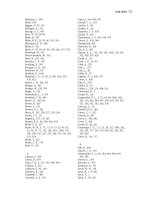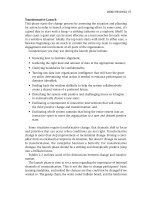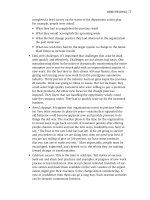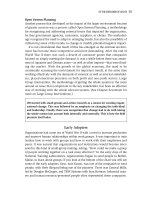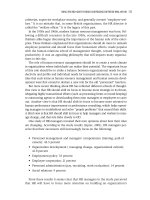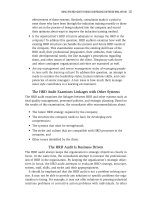Practicing Organization Development (A guide for Consultants) - Part 32 potx
Bạn đang xem bản rút gọn của tài liệu. Xem và tải ngay bản đầy đủ của tài liệu tại đây (274.71 KB, 10 trang )
LAUNCH 281
shown in the model in Exhibit 10.1, there are four major steps in the assessment
process. While this chapter is designed to provide an overview of the assessment
process, there are many good sources that provide the details. Three excellent
sources are David Nadler’s (1977) classic, Feedback and Organization Develop-
ment: Using Data-Based Methods, Church and Waclawski’s (1998) Designing and
Using Organizational Surveys, which provides a comprehensive analysis of the
positives and negatives of methods using technology such as emails or websites,
and Watkins and Mohr (2001), Appreciative Inquiry, which addresses assessment
from an appreciative inquiry perspective.
• Efforts are made to attract, retain, develop, and fully utilize committed and tal-
ented people who are a good fit with the organization.
• Efforts are made to make working conditions and the work environment a
plus rather than a minus.
7. Take Care of Your Customers
• Being customer driven to both internal and external customers is a high priority.
• Employees from top to bottom are encouraged to know their internal and
external customers and their needs.
• Building good relationships with present and potential customers is valued.
• The organization has a reputation for treating customers well.
8. Build Teamwork
• Teamwork is encouraged and developed at the top, within teams, between
teams, and outside the organization with groups key to the success of the
organization.
• There is a one-team mentality with minimal barriers between groups.
• Involvement and collaboration are a way of life.
9. Never Stop Learning, Improving, and Building a Great Organization
• A strong emphasis is placed on continuous learning, improvement, and devel-
opment at the individual, group, and organization levels.
• Many opportunities are provided for people to share ideas and make
improvements.
• Complacency and maintaining the status quo are not options.
10. Keep Score and Get Results
• Measures of excellence are simple and clear and allow the organization to
know where it stands regarding performance, human resource indicators,
culture, customers, and other important measures.
• Decisive decisions are made to make needed adjustments to get the best
results without damaging the culture or compromising the core values.
Practicing Organization Development, 2nd Ed Copyright © 2005 by John Wiley & Sons, Inc. Reproduced
by permission of Pfeiffer, an Imprint of Wiley. www.pfeiffer.com
16_962384 ch10.qxd 2/3/05 12:17 AM Page 281
Planning the Assessment
A well-planned assessment can provide valuable information that can be used
in making organizations, groups, and individuals successful. It can confirm what
is being done right and may also uncover blind spots or potential opportunities
that, when addressed, result in significant improvements or even a turnaround
situation. A poorly planned assessment, however, can demoralize people and
cause division. Therefore, it is very important that someone with experience
and expertise lead the planning process. This is not the place to try to find the
cheapest consultant! The stakes are too high.
The size and scope of the assessment, level of expertise of the person or per-
sons leading the assessment process, and the commitment needed to make the
assessment successful will determine who and how many should be involved
in the planning process. A known, trusted, and experienced internal or exter-
nal OD practitioner may be able to plan an assessment with minimal involve-
ment. However, many efforts require considerable involvement in establishing
goals, agreeing on what and who will be assessed, choosing methods, deciding
on how to collect the data, and fulfilling the other steps in the planning process.
Planning Tips
• It is particularly important in planning the assessment to agree with the
appropriate leaders on how the results will be utilized and to coach
them on how they can help or harm the assessment process.
• Assessments can become colossal failures if leaders are not committed to
doing anything with the results or if they misuse the results. Some lead-
ers have been known to simply file the reports. Others have been known
to chastise employees in general or some in particular for the poor results
or to make hasty decisions that greatly damage the credibility of the
assessment process and may discourage any future assessments.
• A lack of milestones can result in missed deadlines and commitments
and undermine the credibility of the assessment. Particularly damaging
is the failure to feed the results back and involve people in action plan-
ning in a timely manner, which dilutes the value of the data and confi-
dence in the entire OD effort. Fresh data that are delivered and utilized
as quickly as possible are far more motivating than stale data that are
neither delivered nor utilized in a timely fashion.
Data Collection
Technology has made it possible to collect and analyze data very quickly. How-
ever, every situation must be analyzed to determine the most effective and real-
istic way to collect data. For example, while a wealth of information can be
collected and quickly analyzed through questionnaires, people may be more
282 PRACTICING ORGANIZATION DEVELOPMENT, 2ND EDITION
16_962384 ch10.qxd 2/3/05 12:17 AM Page 282
open in face-to-face interviews and communicate things that cannot be picked
up in questionnaires.
The most frequently used methods of data collection are available informa-
tion (an organization’s vision, mission, values, strategic goals, organization
charts, turnover rates, and so forth), using questionnaires and interviews (indi-
vidual and group), and observations. Ideally, both quantitative and qualitative
data are preferable. Quantifiable (most quantifiable data are still subjective) data,
which typically are collected through questionnaires, make it possible to know
the magnitude of an issue. An average of 2.5 on a 7-point scale, with 7 being
the highest favorable score, has a far different meaning from a 6.5. However,
quantitative data will not always tell you what is behind the numbers. Qualita-
tive data are generally collected through one-on-one or group interviews that
make it possible to pick up information and impressions that explore a wide
range of issues, including what is behind the issues.
Data Collection Tips
• Making data collection as user friendly and non-time-consuming as pos-
sible is important.
• Whenever possible, it is usually important to have a top-level leader or
respected professional notify participants in an assessment ahead of
time regarding the purpose and importance of the assessment. Some
credibility is lost when participants are caught off-guard when assess-
ments suddenly appear.
• If both questionnaires and interviews are used, ideally it is better to col-
lect the data from the questionnaires before doing the interviews so that
the interviewers will know ahead of time what to ask and where to
probe. In practical terms, this is rarely possible because of the time it
takes to collect and analyze data.
• Interviews should consist of core questions that are asked of all so there
is consistency in the process and the flexibility to go with the flow.
• With rare exception, anonymous questionnaires will produce far more
valid results than those that are not.
• When interviewing is not feasible, well-designed open-ended question-
naires can capture some of the valuable information normally gained
from interviewing. However, open-ended questionnaires also make data
collection and analysis far more time-consuming for the OD practitioner.
• If open-ended comments are to be used in the reported findings, which
is often the case, it is important to note this in the questionnaire, as
some people may feel that their confidence has been betrayed. It is also
important to decide ahead of time whether to summarize key thoughts
from open-ended comments if a large sample size makes the comments
LAUNCH 283
16_962384 ch10.qxd 2/3/05 12:17 AM Page 283
too numerous for people to read it and whether to report comments ver-
batim or to provide modest editing to eliminate inflammatory comments
and capture thoughts in a more constructive way. (I prefer the latter, as I
have seen unedited comments cause considerable division and conflict.)
The appreciative inquiry approach does have an advantage in this
regard, as the information gathered is positive and uplifting.
• Interviewing in a conference room is to be preferred over interviewing in
offices, as it takes time to go from office to office, and there are many
distractions in offices.
• Never use a tape recorder in interviewing! Tape recorders can be intimi-
dating, and they double the amount of time required of the OD practi-
tioner, as everything must be listened to twice. Most professionals take
their own version of abbreviated notes in interviews, although another
alternative is to use a laptop computer. However, some people being
interviewed may also find this distracting.
• Online questionnaires are less likely to experience contamination from
participants sharing ideas about the questions than are printed question-
naires, but they are also likely to get a smaller response rate for a variety
of reasons, such as some people not being proficient at computers and
others being tired of spending so much time with computers. A good
source for online questionnaires is www.zoomerang.com.
• The highest response rates come from the collective approach, where
opportunities are offered multiple times during the day for groups of
people to complete questionnaires electronically or on paper. However,
the individual approach, where respondents can complete question-
naires at their own discretion by a prescribed due date, is less
complex and labor intensive to organize and manage and provides
greater privacy and more time for respondents to think through their
responses.
• Training may be necessary to provide consistency in the collection of
data. This is particularly true of the appreciative inquiry approaches
because of the uniqueness of how data are collected and analyzed.
Data Analysis
The OD practitioner or practitioners leading an OD process usually compile, ana-
lyze, and prepare a report of the assessment results. Technology has made it
possible to automate the compilation and analysis part of an assessment, and
with large numbers of people being assessed, this is almost a necessity for effi-
cient assessment. The data go in and a report comes out, complete with attrac-
tive charts and graphs. However, no matter how dazzling the technology and
284 PRACTICING ORGANIZATION DEVELOPMENT, 2ND EDITION
16_962384 ch10.qxd 2/3/05 12:17 AM Page 284
resulting report may be, of much greater importance—regardless of how the
data are analyzed and presented—is that the analysis should provide valid and
useful information and that the information should be presented in a way that
is brief and easy to follow and utilize. Some question whether this can be done
solely by machine or without an experienced expert or experts doing the analy-
sis. Nevertheless, the point is that this part of the assessment and action plan-
ning process is extremely important, and a poor analysis or presentation of the
results will lead to a low use and/or misuse of the assessment.
Data Analysis Tips
• A good analysis should involve both deductive and inductive reason-
ing. Deductive reasoning from an OD perspective comes from evaluat-
ing and making conclusions about data based on general theories and
models. This requires OD practitioners to be knowledgeable about OD
and what makes organizations successful. Inductive reasoning comes
from evaluating data based on what emerges from the data itself and
using one’s experience in working with organizations to interpret the
data.
• Multiple sources of data, such as data from questionnaires and inter-
views, make it possible to cross-validate data. In other words, look for
data that support one another.
• Experienced OD practitioners analyzing data not only look for trends
and patterns rather than isolated data that show no consistency with
other data but also have the experience to know when someone sees
something important that others do not see.
• A seasoned person analyzing data will know when some information is
best shared personally or left out of formal reports where the informa-
tion could be inflammatory rather than helpful.
• If sophisticated statistical methods are used in the analysis, good judg-
ment determines how much the statistics are used by the analyst and
how much are used in reporting the results that may confuse the
recipients.
• The main body of reports should be kept brief and arranged so that the
major findings are summarized, easy to understand, and can be used for
action planning. For example, a report could begin with a summary of
important assessment demographics, the major numerical results, the
highest and lowest rated items, and a summary of major strengths and
opportunities for improvement based on an analysis of all sources of
data. This could then be followed by the actual results and open-ended
comments for each question in appendices.
LAUNCH 285
16_962384 ch10.qxd 2/3/05 12:17 AM Page 285
Data Feedback
If and how data are fed back can have a significant impact on the success or
failure of OD efforts. For example, leaders may not like what they see or have
little interest in feeding the data back and therefore forego the feedback process
altogether, or may delay the feedback so long that the data lose their relevance
or motivating potential. When any of these events happens, there will be a loss
of credibility and trust in the OD process and the leaders, which may discour-
age people regarding future change efforts. On the other hand, feedback prop-
erly handled can energize people, create momentum for change, and ensure that
organization members trust and own the data.
The feedback process must be designed for each unique situation, but typi-
cally includes some version of the following steps:
1. A strategy is developed by the OD practitioner in collaboration with the
appropriate people about who gets what information, how, and when.
2. If appropriate, training is provided for those leading feedback sessions
so that there will be consistency in philosophy, methods, and out-
comes in each session.
3. The top-level leader involved will usually be briefed on the findings
and coached on behaviors that tend to help or hinder the feedback
process and what the feedback process consists of.
4. The feedback then is usually presented to the primary group it is
intended for or cascaded down the organization, starting with top
management. Each group receives the information that is appropriate
for it to see and respond to. There are exceptions where a “bottom-up”
approach is used, with recommendations eventually formulated to pre-
sent to top management.
5. While some feedback sessions at this point are designed simply to brief
people on the results, most follow a presentation of the results with
some phase of the action-planning process. For example, a group may
be used to evaluate, validate, and prioritize data and brainstorm alter-
natives and then pass this on to an action planning group, or they may
serve as the action planning group and develop specific actions.
Data Feedback Tips
• Data feedback should be a positive and helpful experience and not a
negative and harmful experience. Early OD efforts often focused pre-
dominantly on what was wrong and how to fix it, took somewhat of a
confrontational, in-your-face approach, and took great pride in doing so.
Being confrontational, getting people to “spill their guts,” and involving
286 PRACTICING ORGANIZATION DEVELOPMENT, 2ND EDITION
16_962384 ch10.qxd 2/3/05 12:17 AM Page 286
people in all kinds of experiential learning became the badge of courage
for some OD practitioners. These approaches gave OD a reputation in
many circles for being a “touchy-feely,” confrontational approach led by
emperors without clothes, who were so engaged in their own
approaches that they did not realize how they, their approaches, and the
field of OD were being perceived by many. However, contemporary OD
focuses more on understanding present realities and future ideals and
how to reach the ideal step by step. It is a much more positive and ener-
gizing approach and recognizes that there are helpful, not just poten-
tially harmful and undiplomatic, ways to deal with reality and tell the
truth. There is also, of course, the appreciative inquiry approach, which
focuses entirely on the positive.
• Prior experience or training is, of course, important for all involved in
the feedback process. However, it is also important to provide at least a
brief amount of training at the beginning of feedback sessions to relieve
anxiety about the findings and how they will be used, to assure people
that the process is intended to be used for helpful and not harmful pur-
poses, and to understand how to interpret and best utilize the informa-
tion. For example, it may be helpful to point out that it is important to
look for patterns and trends rather than some isolated finding.
• Those who want to undermine OD efforts can do so quite skillfully by
trying to discredit some aspect of the assessment process. They know
someone who did not understand how to complete the questionnaire
and others who were too intimidated to be truthful, and they can name
many variables that influenced the results or may challenge the statisti-
cal or sample methods used. This can be overcome by telling partici-
pants in feedback sessions that the data are a starting point for them to
decide what is important. This minimizes criticisms and the need to jus-
tify every detail of the assessment process.
• It is important for people to have feedback on the whole organization
and to have opportunities to contribute to increasing the success of an
organization. However, feedback becomes much more meaningful when
the data can be broken down to pertain directly to groups involved so
that they can contribute and take ownership for things that directly
affect them and that they can directly influence.
• While quantitative and qualitative data are both important and each has
its advantages and disadvantages, quantitative data have an advantage
in motivating change. Executives know how to relate to numbers and
are less likely to dismiss such information. For example, when they see
that morale received a 2.3 rating on a 7-point scale, it is more likely to
get their attention and motivate change than learning that interviews
LAUNCH 287
16_962384 ch10.qxd 2/3/05 12:17 AM Page 287
revealed a morale problem. The most powerful motivator is quantitative
data that is supported by qualitative data.
• Whenever possible, it is helpful to have a knowledgeable person in the
organization review feedback reports before distributing them or sharing
the results. Minor errors, such as wrong names for groups or misspelled
words or numerical errors, can raise doubts about the accuracy of the
results.
Assessment Methods
One of the many interesting aspects of assessing organizations is that a variety
of methods can be used to find out what is going on and what is possible. Each
method has advantages and disadvantages. For example, interviews and ques-
tionnaires are the most frequently used methods, but both have advantages and
disadvantages. Interviews make it possible to collect a wide variety of data, find
out what is behind issues, and see and dialogue with respondents, but may suf-
fer from interviewer bias. However, they also can be time-consuming and expen-
sive if a consultant is used and large numbers of people are interviewed.
Questionnaires make data quantifiable, but may suffer from respondent bias
and are not likely to reveal what is behind the numbers. A summary of the
major advantages and disadvantages of various assessment methods is shown in
Exhibit 10.3, and a brief discussion of the methods follows.
288 PRACTICING ORGANIZATION DEVELOPMENT, 2ND EDITION
Exhibit 10.3. Advantages and Disadvantages of Organization Assessment Methods
Method Advantages Disadvantages
Examining Existing Data
• Past and present • Information already exists • Reality between what is
published information • Generally easy to access stated and what is may
• Brochures • Quickly familiarizes the differ
• Vision, mission, values, person doing the assess- • Some existing
goals statements ment with the organization information may be
• Organization charts • Efficient and inexpensive difficult to access
• Available data on profits, • Relatively objective • Gives only a surface
sales, turnover, etc. view of the organization
16_962384 ch10.qxd 2/3/05 12:17 AM Page 288
LAUNCH 289
Method Advantages Disadvantages
Interviews
• Structured (specific • Makes it possible to • Can be time-consuming
questions designed to collect rich, valuable, and expensive if large
elicit specific responses) in-depth information number of respondents
• Non-structured • Can be used for a wide involved
(open-ended questions) range of assessment • Subject to interviewer
• Individual purposes bias and influence
• Group • Makes it possible to • Interpreting and
• Face-to-face probe and elaborate on summarizing information
• Phone or electronic information and pursue from interviews can be
new lines of questioning difficult
• Can build empathy, trust, • May not give a sense
support for OD efforts of magnitude or
importance of
information collected
• Risks inconsistencies
in interviewing style and
interpretation of the
results if more than one
interviewer involved
Questionnaires
• Used to gather data on • Make it possible to • Misses qualitative data
whole organizations, quantify and objectively especially if open-ended
groups, or individuals, analyze results questions not included
or a specific focus • Can survey and involve • May not reveal what is
• Quantifiable large numbers of people behind the numbers
• Open-ended questions • Numbers and a sense of • Lacks the flexibility of
magnitude can be strong interviews
motivators for change • Subject to respondent
• Relatively inexpensive bias, especially if
• Can seed the organization respondents lack
for change knowledge pertaining to
• Can compare before and some questions
after results • Interpreting and
summarizing data may
require a high level of
expertise
16_962384 ch10.qxd 2/3/05 12:17 AM Page 289
Examining Existing Information. This part of the assessment begins when an
OD practitioner first gets involved and starts learning about an organization. It
serves as a first step in the assessment process, even though it often precedes
a formal assessment. It could include, for example, studying past and present
information available on the organization, including information published by or
about an organization, such as an organization’s history; reputation; past and
present success; and brochures or publications that may describe the organiza-
tion’s vision, mission, core values, strategic goals, organization chart, and prod-
ucts and services. It could include information on turnover rates, absenteeism,
or even prior assessments. The goal of this search for information is to become
a knowledgeable student of the organization.
290 PRACTICING ORGANIZATION DEVELOPMENT, 2ND EDITION
Exhibit 10.3. Continued
Method Advantages Disadvantages
Observations
• Formal (specific things to • Organization behavior, • Not always easy to
observe and information processes, and systems arrange and can be
to collect) can be observed first-hand distracting to those
• Informal (observing, • Can obtain a better feel being observed
talking, attending for the culture of the • Possible observer bias in
meetings, etc.) organization or group interpreting what is
• Real-time data observed
• Flexibility in terms of what • Can be expensive and
is observed time-consuming for the
value received
• May be difficult to
analyze what is observed
Live Assessments
• Data collected and • Interesting, engaging, • May miss valuable
analyzed live at meetings real time, and provides information that comes
and workshops fast turnaround and use from a variety of sources
• Data collected and of information over time
analyzed in real time • With skilled facilitator can • Dependent on having
electronically be used with large groups key people present or
of people commitment may be lost
• Quickly involves people • Somewhat risky in the
and builds commitment event that unforeseen
to change things can happen that
undermine the process
16_962384 ch10.qxd 2/3/05 12:17 AM Page 290
